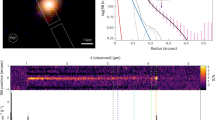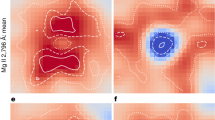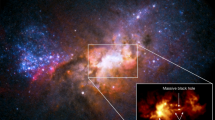Abstract
The stellar mass in disc galaxies scales approximately with the fourth power of the rotation velocity, and the masses of the central black holes in galactic nuclei scale approximately with the fourth power of the bulge velocity dispersion. It is shown here that these relations can be accounted for if, in a forming galaxy with an isothermal mass distribution, gas with a column density above about 8 M⊙ pc−2 goes into stars, whereas gas with a column density above about 2 g cm−2 (104 M⊙ pc−2) goes into a central black hole. The lower critical value is close to the column density of about 10 M⊙ pc−2 at which atomic gas becomes molecular, and the upper value agrees approximately with the column density of about 1 g cm−2 at which the gas becomes optically thick to its cooling radiation. These results are plausible because molecule formation is evidently necessary for star formation, and because the onset of a high optical depth in a galactic nucleus may suppress continuing star formation and favour the growth of a central black hole.
This is a preview of subscription content, access via your institution
Access options
Subscribe to this journal
Receive 12 print issues and online access
$259.00 per year
only $21.58 per issue
Buy this article
- Purchase on SpringerLink
- Instant access to full article PDF
Prices may be subject to local taxes which are calculated during checkout
Similar content being viewed by others
References
Larson, R. B. Angular momentum and the formation of stars and black holes. Rep. Prog. Phys. (in the press); preprint at <http://arxiv.org/abs/0901.4325> (2009).
Tully, R. B. & Fisher, J. R. A new method of determining distances to galaxies. Astron. Astrophys. 54, 661–673 (1977).
Kassin, S. A. et al. The stellar mass Tully–Fisher relation to z=1.2 from AEGIS. Astrophys. J. 660, L35–L38 (2007).
Williams, M. J., Bureau, M. & Cappellari, M. in Galaxy Evolution: Emerging Insights and Future Challenges (eds Jogee, S., Hao, L., Blanc, G. & Marinova, I.) (Astron. Soc. Pacific, 2009) (in the press); preprint at <http://arxiv.org/abs/0902.1500> (2009).
Kormendy, J. & Richstone, D. Inward bound—the search for supermassive black holes in galactic nuclei. Annu. Rev. Astron. Astrophys. 33, 581–624 (1995).
Ferrarese, L. et al. A fundamental relation between compact stellar nuclei, supermassive black holes, and their host galaxies. Astrophys. J. 644, L21–L24 (2006).
Gültekin, K. et al. The M–σ and M–L relations in galactic bulges, and determinations of their intrinsic scatter. Astrophys. J. 698, 198–221 (2009).
Binney, J. & Tremaine, S. Galactic Dynamics 2nd edn (Princeton Univ. Press, 2008).
Downes, D. & Solomon, P. M. Rotating nuclear rings and extreme starbursts in ultraluminous galaxies. Astrophys. J. 507, 615–654 (1998).
Krumholz, M. R., McKee, C. F. & Tumlinson, J. The atomic-to-molecular transition in galaxies. II: HI and H2 column densities. Astrophys. J. 693, 216–235 (2009).
Martin, C. L. & Kennicutt, R. C. Star formation thresholds in galactic disks. Astrophys. J. 555, 301–321 (2001).
Schaye, J. Star formation thresholds and galaxy edges: Why and where. Astrophys. J. 609, 667–682 (2004).
Robertson, B. E. & Kravtsov, A. V. Molecular hydrogen and global star formation relations in galaxies. Astrophys. J. 680, 1083–1111 (2008).
Shlosman, I. & Begelman, M. C. Evolution of self-gravitating accretion disks in active galactic nuclei. Astrophys. J. 341, 685–691 (1989).
Goodman, J. Self-gravity and quasi-stellar object disks. Mon. Not. R. Astron. Soc. 339, 937–948 (2003).
Tan, J. C. & Blackman, E. G. Star-forming accretion flows and the low-luminosity nuclei of giant elliptical galaxies. Mon. Not. R. Astron. Soc. 362, 983–994 (2005).
Larson, R. B. The physics of star formation. Rep. Prog. Phys. 66, 1651–1697 (2003).
Morris, M. & Serabyn, E. The galactic center environment. Annu. Rev. Astron. Astrophys. 34, 645–701 (1996).
Solomon, P. M., Downes, D., Radford, S. J. E. & Barrett, J. W. The molecular interstellar medium in ultraluminous infrared galaxies. Astrophys. J. 478, 144–161 (1997).
Semenov, D., Henning, Th., Helling, Ch., Ilgner, M. & Sedlmayr, E. Rosseland and Planck mean opacities for protoplanetary disks. Astron. Astrophys. 410, 611–621 (2003).
Larson, R. B. Thermal physics, cloud geometry and the stellar initial mass function. Mon. Not. R. Astron. Soc. 359, 211–222 (2005).
Jappsen, A.-K., Klessen, R. S., Larson, R. B., Li, Y. & Mac Low, M.-M. The stellar mass spectrum from non-isothermal gravoturbulent fragmentation. Astron. Astrophys. 435, 611–623 (2005).
Li, Y., Klessen, R. S. & Mac Low, M.-M. The formation of stellar clusters in turbulent molecular clouds: Effects of the equation of state. Astrophys. J. 592, 975–985 (2003).
Bonnell, I. A. & Rice, W. K. M. Star formation around supermassive black holes. Science 231, 1060–1062 (2008).
Bartko, H. et al. An extremely top-heavy IMF in the Galactic Center stellar disks. Astrophys. J. (in the press); preprint at <http://arxiv.org/abs/0908.2177> (2009).
Krumholz, M. R. & McKee, C. F. A minimum column density of 1 g cm−2 for massive star formation. Nature 451, 1082–1084 (2008).
Thompson, T. A., Quataert, E. & Murray, N. Radiation pressure-supported starburst disks and active galactic nucleus fueling. Astrophys. J. 630, 167–185 (2005).
Larson, R. B. in The Formation and Evolution of Planetary Systems (eds Weaver, H. A. & Danly, L.) 31–54 (Cambridge Univ. Press, 1989).
Larson, R. B. Non-linear acoustic waves in discs. Mon. Not. R. Astron. Soc. 243, 588–592 (1990).
Hopkins, P. F., Murray, N., Quataert, E. & Thompson, T. A. A maximum stellar surface density in dense stellar systems. Mon. Not. R. Astr. Soc. (in the press); preprint at <http://arxiv.org/abs/0908.4088> (2009).
Author information
Authors and Affiliations
Corresponding author
Ethics declarations
Competing interests
The author declares no competing financial interests.
Rights and permissions
About this article
Cite this article
Larson, R. Role of column density in the formation of stars and black holes. Nature Phys 6, 96–98 (2010). https://doi.org/10.1038/nphys1484
Received:
Accepted:
Published:
Issue date:
DOI: https://doi.org/10.1038/nphys1484
This article is cited by
-
What's hot and what's not
Nature Physics (2010)



